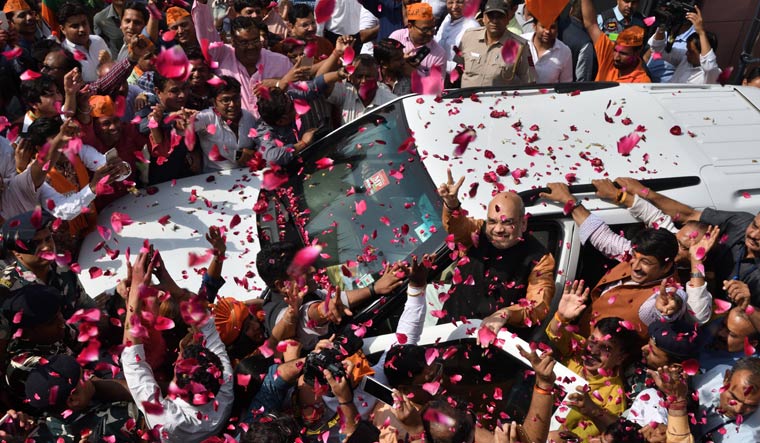Tripura was the first direct contest between the two parties known to be at the extreme ends of the ideological divide in India—left versus right. The victory for the BJP in Tripura tastes sweeter for the saffron party precisely for the same reasons. Now, Kerala is the only state with a Communist government.
The BJP victory in Tripura is a copybook example of the strategy it has been using in other states—build up a grassroots organisation, capture people's imagination with promises of better governance, bring leaders from other parties and finally bombard the election state with campaigning by heavyweight politicians.
The 'poorest' chief minister of the country, Manik Sarkar, could not save his citadel from the superior war machinery deployed by Prime Minister Narendra Modi and BJP chief Amit Shah.
By afternoon, the trends indicated that the BJP had received over 40 per cent more votes than the 2013 elections when it could only gather 1.5 per cent. The CPI(M) with 48 per cent votes in the 2013 Assembly polls saw its share drop by five per cent, which is not really a massive drop.
The Tripura victory saw the complete decimation the Congress. Look at the vote share: during the 2013 elections, the Congress was the main opposition party with 10 seats and 36.5 percent vote share. This time, it could only gather 1.6 per cent, which means the entire anti-government vote had transferred en masse to the new challenger in the ring.
The four key strategists for the BJP victory in Tripura were party chief Amit Shah, general secretary Ram Madhav, Assam deputy CM Hemanta Biswa Sarma and finally the main 'operational' man on the ground, Sunil Deodhar.
Deodhar was instrumental in raising an army of workers in the state. The BJP had made 42,000 panna pramukhs (page in-charges)—one each for the all the pages in the state voter list. Each page has around 60 names. So in the past two months, these pramukhs along with a team of activists had visited each voter several times, talking about the achievements of the Modi government and the promises of what the BJP would do when it came to power.
The BJP focussed on getting the support of the state's employees by promises to give them salaries according to the Seventh Pay Commission, as the state was still following the recommendations of the Fourth Pay Commission.
Starting with Modi, all senior leaders of the BJP had campaigned in the state. In fact, Union ministers visited the state every month on official tours in the past two years. This bombardment of leaders was aimed at creating a huge population of aspirational young voters who wanted change.
The BJP also entered into a partnership with the IPFT, a tribal party, which helped it garner tribal votes in each of the constituencies, which in the end made all the difference.
The CPI(M) has been dislodged from the state, but its vote share may be the only consolation. Madhav acknowledged the “spirited fight” put up by Sarkar and his party.
While the result is clear in Tripura, the BJP despatched Sarma and Madhav to neighbouring Meghalaya and Nagaland to explore the possibilities of creating BJP governments there at all costs.


